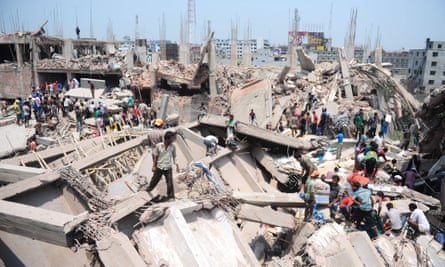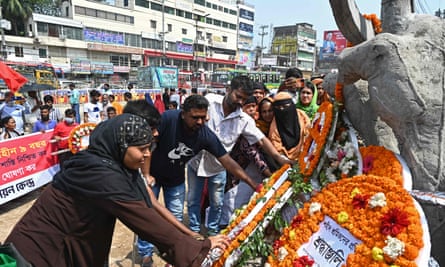The fight for safe conditions and fair pay in Bangladesh has not yet been won, campaigners are warning on the 10th anniversary of the deadliest disaster in the garment industry’s history.
On 24 April 2013, 1,134 people were killed and at least another 2,000 injured in the collapse of a factory building in Dhaka, Bangladesh, where clothing was being made for international brands including Primark, Bonmarché and Canada’s Loblaw.
The owner of the Rana Plaza building remains in prison but the murder trial against him and others, including factory owners and local officials, continues to grind on almost seven years since charges were brought, with no one yet to be convicted.
Campaigners say workers in Bangladesh, which is the second-largest exporter of clothing in the world behind China, are still underpaid and can be harassed for being part of a union, while factory owners face sharp practices from brands such as delaying payments, cancelling or dramatically reducing orders without notice.
Paul Nowak, the general secretary of the Trades Union Congress in the UK, said: “Ten years after more than a thousand workers died in the Rana Plaza factory collapse, labour rights abuses are still rife in Bangladesh and many are still working in unsafe conditions.
“Relentless union campaigning secured important safety protections for factory workers. But many non-factory workers do not have the same protections.”

Moushumi Begum, who spent three hours trapped under the eight-storey Rana Plaza, said: “It all happened so quickly. I vividly remember every detail about that day, even though it was 10 years ago.”
After the building collapsed, Begum spent the next three hours fighting for her life. “Every second of those hours, I lay there praying to Allah. It was dark all around me and I couldn’t tell if I was dead or alive,” she said on a sunny afternoon in Savar, on the outskirts of Dhaka, while cradling her baby.
“I could hear people screaming and crying out for help. But I had taken in so much dust that every time I tried to open my mouth, no sound came out,” she added.
Husnara Akhtar, 30, recalled having breakfast with her husband, Abu Sufyan, before they made their way to work that day. “He always took four spoons of sugar with his tea and it drove me crazy,” she said, staring blankly at her own cup as she spoke.
The couple had both worked in the Rana Plaza building, though for different factories, said Akhtar: “He was on the 5th floor and I was on the 7th but we always had lunch together. He would wait for me by the gates after work so we could go home together. I last saw him alive by those gates … Little did I know how my life would change that day.”
When Akhtar gained consciousness, after the building’s collapse, she found herself wedged between two dead bodies. Her husband’s body was found a week later, crushed under a concrete pillar.

A positive legacy of the tragedy has been the creation of one of the world’s toughest factory safety agreements, which has brought together brands, manufacturers and union representatives to check and fix buildings and advise workers of their rights.
Called the accord on fire and building safety in Bangladesh, it legally bound fashion brands to help pay for safety inspections and remediation in the country’s clothing industry. To date, there have been nearly 56,000 safety inspections across more than 2,400 garment factories in Bangladesh and more than 140,000 safety improvements made.
More than two million workers are protected by the factory refurbishments. Although a similar number work in other factories not covered by the accord, their working conditions have had more oversight from government-backed inspections since an increase in international scrutiny.
Brands have contributed at least $3m (£2.4m) to helping renovate factories in Bangladesh. Primark, Walmart, Zara’s owner Inditex and H&M were among those that contributed to a $30m compensation fund for the families of the people who died or were injured in the Rana Plaza disaster.
In 2021, an expanded international accord was developed that included more safety and worker health provisions beyond fire, electrical and structural inspections and repairs of factories. It also committed brands to develop a similar structure in Pakistan and at least one other country.
To date, at least 46 brands and retailers have signed the Pakistan accord, which is expected to protect 750,000 workers, although inspections are only now getting under way.

However, campaigners say some big multinationals including Levi’s, Gap, Walmart and Amazon have yet to sign up to the Bangladesh factory safety deal.
Atle Høie is the general secretary of IndustriALL, a global union federation that played a key role in negotiating that accord. He said: “Although significant progress in Bangladesh’s garment industry has been made, safe factories still need to be fought for. Workers who produce the clothes that we wear deserve a workplace that provides them with a living wage and decent working conditions, not a workplace that threatens to take their lives.
“More brands need to join the accord, especially in North America, to gain the leverage we need to extend it to more countries and make it truly global.”
Levi’s said the accord was “not the only way to support workers in Bangladesh or anywhere else”. The company said it was confident in its own system of factory oversight that provided “checks and balances [and] helped us go further and gave us greater agility”.
Walmart said it remained committed to sourcing from factories that maintained safe working environments. The US retailer signed up to the Alliance for Bangladesh Worker Safety. After the dissolution of the alliance came the formation of Nirapon, a self-regulatory body that aims to regulate factories but does not have legally binding commitments.
Kalpona Akter, the founder and executive director of the grassroots organisation Bangladesh Center for Workers’ Solidarity, said the achievement of persuading brands and factory owners to sign up to the accord should not be underestimated.
“No one believed this agreement was even possible,” she said. “Definitely we made a fundamental difference on [factory] safety but when we talk about other rights of workers such as wages and gender-based violence it is still there.”
Akter said the pandemic, during which many factories were forced to close, leaving workers without pay in many cases, “showed how vulnerable workers” were and highlighted how they needed spare cash for emergencies.
Michael Posner, a former assistant secretary of state for democracy, human rights and labour in the Obama administration, agreed.
“Relationships between Bangladeshi factory owners and their corporate customers, which were badly strained by the Covid pandemic, have continued to squeeze the factory owners, and this exploitation leads to worse conditions for workers,” said Posner, who is director of the NYU Stern Center for Business and Human Rights.
Posner said he wanted to see more transparency on retail supply chains and commitments to payment deadlines. “Global fashion brands need to accept their share of the responsibility for ensuring the wellbeing of factory workers whose labour is a crucial component of the continued growth and vitality of this industry,” he said.
Now campaigners want brands to sign up to a new deal which would support a living wage.
Since the Rana Plaza disaster, the minimum wage in the garment sector in Bangladesh has been reviewed every five years. The minimum was last reviewed in 2018, when it was set at 8,000 BDT (about £61) a month, half what workers were demanding.
This wage, which was not seen as enough to get by on five years ago, is still in place, despite hefty inflation and widespread worker protest.
Akter said: “The war in Ukraine has hit every single person’s kitchen. Even though so much work has been done, there is a whole system [that doesn’t work]. More than ever before, brands listen to consumers through social media, especially in Europe. Consumer pressure can bring some brands to the table.”
